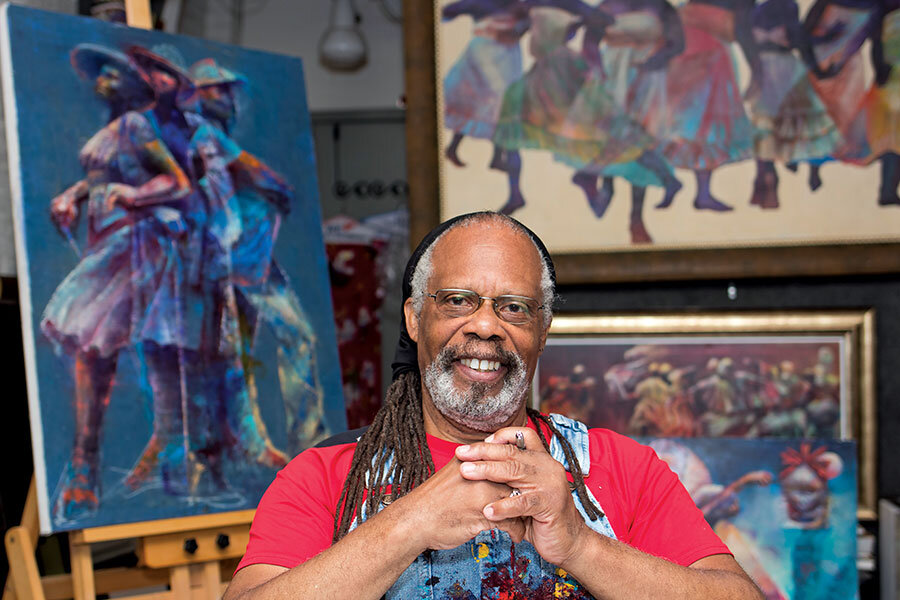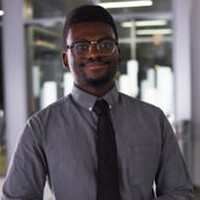This artist’s vision prioritizes community and healing
Loading...
| Boston
Inside Paul Goodnight’s art studio, hundreds of vibrant paintings fill the space from floor to ceiling. In each one, black bodies appear to move in intricate ways, and washes of color fill the canvases like spots of colored lights at a disco.
As a painter, Mr. Goodnight strives to convey the beauty of the African diaspora. But his work is more than that: Describing himself as a “citizen first and then an artist,” he uses his paintbrush to tell the stories of communities and present their issues in a new light.
Goodnight has gained recognition for his socially conscious work, which spans decades and continents. He has brought students together at a school that was struggling with racism, mentored young artists, and even aided Sierra Leone refugees in coping with trauma from war.
“I feel like images can help tell a story. And not only help tell a story, it can also benefit the community in a way that they had never thought of before,” says Goodnight as he sits in his Boston studio wearing his signature paint-splattered overalls and a do-rag tied over dreadlocks.
Why We Wrote This
Internationally acclaimed artist Paul Goodnight uses his paintbrush to help communities see their issues in a new light. Over the course of his prolific career, he's started charities, led art therapy, and created influential public works.
Goodnight grew up in the South End of Boston in a large African-American family. As a young boy, he developed a passion for painting and drawing. In fact, once when he was sent to his room for misbehaving, he was excited because it was a chance to draw.
But as he became an adult, his passion had to be put on hold because he was drafted into the Vietnam War. He says that when he returned, he was so traumatized by the violence he had witnessed that he was rendered speechless. So to cope, he created a voice for himself through art.
Over the years, Goodnight’s work has resonated with the African-American community, so much so that his paintings have found their way onto the sets of TV shows such as “Martin” and “Living Single” and into the private collections of celebrities including actor Wesley Snipes and basketball Hall of Famer Isiah Thomas. In the art world, his paintings have hung in the Smithsonian, the Museum of the National Center of Afro-American Artists (NCAAA), and the National Museum of Ghana, to name a few.
Goodnight has traveled to and lived in a variety of places, including Sierra Leone, Russia, China, Uganda, Senegal, and Brazil. Many of these locales have become home.
“[Goodnight’s art] has an international flavor to it, directed more specifically toward black culture,” says longtime colleague and Boston activist Sadiki Kambon, who worked with Goodnight to create a T-shirt design for the Boston contingent of the Million Man March in 1995. “It’s significant to me because it highlights the importance of our culture and particularly our family and our ancestors.” He adds, “You get a sense of pride when you see the work that Paul does. It makes you feel good about who you are as a black person.”
Community artist
One of Goodnight’s first major public works was created in the Boston area. In 1982, he had undertaken a three-month teaching residency at Lincoln-Sudbury Regional High School, where racial tensions were simmering between some black students and a predominantly white student body. Wanting to help, he stepped in with some buckets of paint.
Goodnight and the black and white students teamed up to draw their learning experiences growing up. The result was a mural titled “Education in a Different Way.”
“It was uniting because the black students and the white students were working together again, and they were working together on something positive and not negative,” Goodnight recalls.
He was selected to design commemorative posters for the 1996 Summer Olympics in Atlanta and the 1998 World Cup in France. His work won him a Sport Artist of the Year Award from the United States Sports Academy in 1996 and a 21st Century Award from the Urban League of Eastern Massachusetts, among others.
Edmund Barry Gaither, director and curator of the Museum of the NCAAA, says Goodnight is at the forefront of an important tradition in 20th-century African-American art. “What he does ... normalizes [the] black experience and its representation.... Paul, over his career and given the consistency with which he has been interested in this subject matter, really is the [newer] generation figure substantially moving forward,” Dr. Gaither says.
Art as a healing agent
Goodnight’s experience in the Vietnam War is also a big factor in his work. Namely, he uses art to heal the emotional scars of violence. When a friend suggested he participate in a service trip to Sierra Leone several years ago to help people who had endured amputations because of the civil war, he jumped at the chance.
With art serving as a form of therapy, the survivors drew their experiences. And Goodnight offered to paint their portraits, with one condition: They had to tell him their stories.
In his Boston studio, Goodnight pulls out a small stack of papers held together by a paper clip. It’s a makeshift journal written by a 13-year-old boy with detailed drawings of the civil war. On one page, a man holds a machete to a woman carrying her child.
The woman is the boy’s mother, who eventually lost her legs in the battle to save his life.
Tucked in the stack of papers is a photo of the mother sitting in a wheelchair with both of her legs amputated. She sits proudly next to her son, who is all grown up.
“He said, ‘I’m going to give you this picture of [my] mother ... and I know you’re the right person to give it to,’ ” Goodnight recalls.
Touched by the man’s trust in him, Goodnight painted a picture, which he says he donated to Hampton University in Virginia as part of an effort to raise money for the man’s siblings to come to the US for an education.
Over his career, Goodnight has also focused on something more mundane yet important: the need for artists to develop business skills. So during the early 1990s he and others founded Color Circle Art, which teaches young aspiring artists business skills like reading contracts and understanding commissions. The organization also funds scholarships and grants.
One of the first people Goodnight mentored is Iropa Keinkede, who took sketch classes with him. Goodnight quickly recognized his potential and funded him to take classes at the Massachusetts College of Art and Design in Boston. Mr. Keinkede hopes to pursue comic book art and like Goodnight wants to create a dialogue around race.
“He’s a great teacher.... I like the way he draws: It just reminds me of comics drawings,” Keinkede says. “We need good imagery of African-American people ... and it’s good to see that. A lot of comics that I read are of white people.”
Goodnight’s calendar brims with projects, collaborations, and art classes. He is taking a sculpture class to continue learning new ways to tell stories, and along with another artist, he is working on a statue of social reformer Frederick Douglass that is to be placed on Boston’s Tremont Street.
“You’re never done with anything you love,” Goodnight says. “Love continues to grow within you. How can you be done with anything like that?”
• For more, visit goodnightart.biz.
Three groups with an arts component
UniversalGiving helps people give to and volunteer for top-performing charitable organizations around the world. All the projects below are vetted by UniversalGiving; 100 percent of each donation goes directly to the listed cause.
• Shirley Ann Sullivan Educational Foundation improves the quality of life for children by providing education and lobbying for their protection from exploitation.
• Light and Leadership Initiative responds to the needs of women living in part of Lima, Peru. Take action: Donate money for a music initiative at this group’s teen center.
• Sanaga-Yong Chimpanzee Rescue provides sanctuary for orphaned chimpanzees in Cameroon while supporting habitat protection and other measures. Take action: Help pay for a five-day classroom program that focuses on environmental stewardship and includes interactive art.






